This is an opinionated set of configurations for managing a Cloud Native platform using GitOps principles.
This repository provides a comprehensive guide and set of tools for building, managing, and maintaining a Cloud Native platform. It includes configurations for Kubernetes, Crossplane, Flux, Vault, and more, with a focus on security, scalability, and best practices.
- Reference Repository for Building a Cloud Native Platform
- 💬 Discussions: Explore improvement areas, define the roadmap, and prioritize issues. Feel free to ask any questions 🙏.
- 🛠️ Issues: Track tasks and report bugs to ensure prompt resolution.
- 📅 Project: Detailed project planning and prioritization information.
Here is the big picture inspired by the CNOE reference implementation.
ℹ️ This repository is used to write new blog posts here
Flux is a set of continuous and progressive delivery solutions for Kubernetes that automate the application deployment process. The following diagram illustrates the key dependencies in our setup:
graph TD;
Namespaces-->CRDs;
CRDs-->Crossplane;
Crossplane-->EPIs["EKS Pod Identities"];
EPIs["EKS Pod Identities"]-->Security;
EPIs["EKS Pod Identities"]-->Infrastructure;
EPIs["EKS Pod Identities"]-->Observability;
Observability-->Tooling;
Infrastructure-->Tooling;
Security-->Infrastructure;
Security-->Observability
This diagram can be hard to understand so these are the key information:
-
Namespaces - Namespaces are the foundational resources in Kubernetes. All subsequent resources can be scoped to namespaces.
-
Custom Resource Definitions (CRDs) - CRDs extend Kubernetes' capabilities by defining new resource types. These must be established before they can be utilized in other applications.
-
Crossplane - Utilized for provisioning the necessary infrastructure components within Kubernetes.
-
EKS Pod Identities - Created using Crossplane, these identities are necessary to grant specific AWS API permissions to certain cluster components.
-
Security - Among other things, this step deploys
external-secretswhich is essential to use sensitive data into our applications
When the cluster is initialized, we define the permissions for the Crossplane controllers using Terraform. This involves attaching a set of IAM policies to a role. This role is crucial for managing AWS resources, a process known as IRSA (IAM Roles for Service Accounts).
We prioritize security by adhering to the principle of least privilege. This means we only grant the necessary permissions, avoiding any excess. For instance, although Crossplane allows it, I have chosen not to give the controllers the ability to delete stateful services like S3 or RDS. This decision is a deliberate step to minimize potential risks.
Additionally, I have put a constraint on the resources the controllers can manage. Specifically, they are limited to managing only those resources which are prefixed with xplane-. This restriction helps in maintaining a more controlled and secure environment.
Crossplane allows provisioning and managing Cloud Infrastructure (and even more) using native Kubernetes features. It needs to be installed and set up in three successive steps:
- Installation of the Kubernetes operator.
- Deployment of the AWS provider, which provides custom resources, including AWS roles, policies, etc.
- Installation of compositions that will generate AWS resources.
🏷️ Related blog posts:
- Going Further with Crossplane: Compositions and Functions
- My Kubernetes Cluster (GKE) with Crossplane
The Harbor installation follows best practices for high availability. It leverages recent Crossplane features such as Composition functions:
- External RDS database
- Redis cluster using the Bitnami Helm chart
- Storing artifacts in S3
🏷️ Related blog post: Going Further with Crossplane: Compositions and Functions
The VPN configuration is done within the terraform/network directory.
You can follow the steps described in this README in order to provision a server that allows to access to private resources within AWS.
Most of the time we don't want to expose our resources publicly. For instance our platform tools such as Grafana, Harbor should be access through a secured wire.
The risk becomes even more significant when dealing with Kubernetes' API. Indeed, one of the primary recommendations for securing a cluster is to limit access to the API.
Anyway, I intentionnaly created a distinct directory that allows to provision the network and a secured connection. So that there are no confusion with the EKS provisionning.
🏷️ Related blog post: Beyond Traditional VPNs: Simplifying Cloud Access with Tailscale
The Vault creation is made in 2 steps:
- Create the cluster as described here
- Then configure it using this directory
ℹ️ The provided code outlines the setup and configuration of a highly available, secure, and cost-efficient HashiCorp Vault cluster. It describes the process of creating a Vault instance in either development or high availability mode, with detailed steps for initializing the Vault, managing security tokens, and configuring a robust Public Key Infrastructure (PKI) system. The focus is on balancing performance, security, and cost, using a multi-node cluster, ephemeral nodes with SPOT instances, and a tiered CA structure for digital security.
🏷️ Related blog post: TLS with Gateway API: Efficient and Secure Management of Public and Private Certificates
We leverage Dagger for all our CI tasks. Here's what is currently run:
- Validation of Kubernetes and Kustomize manifests using
kubeconform - Validation of Terraform/Opentofu configurations using the pre-commit-terraform
For enhanced security and access to private endpoints, our CI tasks can be run on our internal platform using Self-Hosted GitHub Runners.
This feature can be enabled within the tooling kustomization. By leveraging self-hosted runners, we achieve:
- Access to Private Endpoints: Directly interact with internal resources that are not publicly accessible.
- Increased Security: Run CI tasks within our secure internal environment.
For detailed information on setting up and using GitHub Self-Hosted Runners, please refer to this documentation.
🏷️ Related blog post: Dagger: The missing piece of the developer experience
